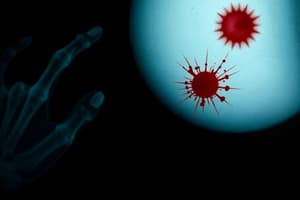Podcast
Questions and Answers
What is the difference between qualitative and quantitative measurements?
What is the difference between qualitative and quantitative measurements?
Qualitative is data that is not numerical; quantitative is measurement of data that can be put into numbers.
Which bones proved most useful in determining sex, race, and height? (Select all that apply)
Which bones proved most useful in determining sex, race, and height? (Select all that apply)
- Humerus (correct)
- Femur (correct)
- Tibia (correct)
- Skull (correct)
- Pelvis (correct)
What is the function of a restriction enzyme?
What is the function of a restriction enzyme?
They recognize specific sequences in DNA and cut the DNA to produce fragments, called restriction fragments.
In what organisms do restriction enzymes evolve and what was their purpose?
In what organisms do restriction enzymes evolve and what was their purpose?
What is a palindromic restriction site?
What is a palindromic restriction site?
What does the term 'sticky end' refer to in the context of restriction enzymes?
What does the term 'sticky end' refer to in the context of restriction enzymes?
What is the purpose of conducting gel electrophoresis?
What is the purpose of conducting gel electrophoresis?
Why must DNA be digested before gel electrophoresis?
Why must DNA be digested before gel electrophoresis?
What is the purpose of the agarose gel in gel electrophoresis?
What is the purpose of the agarose gel in gel electrophoresis?
What is the function of the electric current in gel electrophoresis?
What is the function of the electric current in gel electrophoresis?
What would happen if a student group put their DNA in the electrophoresis box incorrectly?
What would happen if a student group put their DNA in the electrophoresis box incorrectly?
Why is it useful to use more than one restriction enzyme during DNA fingerprinting?
Why is it useful to use more than one restriction enzyme during DNA fingerprinting?
Flashcards
Qualitative Data
Qualitative Data
Data described with words, not numbers. Like colors, textures, or smells.
Quantitative Data
Quantitative Data
Data that can be measured with numbers. Like height, weight, or temperature.
Restriction Enzyme
Restriction Enzyme
A special type of protein that cuts DNA at specific points.
Restriction Site
Restriction Site
Signup and view all the flashcards
Palindromic Restriction Site
Palindromic Restriction Site
Signup and view all the flashcards
Sticky Ends
Sticky Ends
Signup and view all the flashcards
Gel Electrophoresis
Gel Electrophoresis
Signup and view all the flashcards
Digesting DNA
Digesting DNA
Signup and view all the flashcards
Agarose Gel
Agarose Gel
Signup and view all the flashcards
Electric Current
Electric Current
Signup and view all the flashcards
DNA Fingerprinting
DNA Fingerprinting
Signup and view all the flashcards
Using Multiple Restriction Enzymes
Using Multiple Restriction Enzymes
Signup and view all the flashcards
Study Notes
Measurement Types
- Qualitative measurements provide non-numerical data, while quantitative measurements produce numerical values.
Skeletal Indicators
- Pelvis, skull, femur, tibia, and humerus are key bones for determining sex.
- Skull is primarily used for race determination.
- Femur, tibia, and humerus are utilized for estimating height.
Restriction Enzymes
- Restriction enzymes identify specific DNA sequences and cut the DNA to produce fragments known as restriction fragments.
Evolution and Purpose
- Restriction enzymes evolved in bacteria primarily for defense against viral DNA.
Palindromic Restriction Sites
- A palindromic restriction site is a specific DNA sequence recognized by restriction enzymes that reads the same forwards and backwards.
Sticky Ends
- "Sticky ends" refer to the overhanging single-stranded DNA left after a restriction enzyme cuts DNA, capable of base pairing with complementary strands.
Gel Electrophoresis
- Gel electrophoresis is conducted to analyze and compare DNA sequences for alterations or matches.
DNA Digestion
- DNA must be digested into fragments prior to gel electrophoresis to create distinct bands for analysis.
Agarose Gel Role
- Agarose gel serves as a medium for DNA to migrate through, organizing the DNA fragments based on size.
Electric Current Function
- The electric current pushes negatively charged DNA through the gel during electrophoresis.
Incorrect DNA Orientation
- If DNA is placed with wells towards the positive end, it won't move because negatively charged DNA is attracted to the positive end.
Multiple Restriction Enzymes
- Using multiple restriction enzymes in DNA fingerprinting improves accuracy by providing more data points for comparison.
Studying That Suits You
Use AI to generate personalized quizzes and flashcards to suit your learning preferences.


